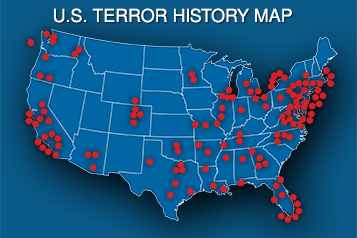From: "Chapter 8; Foreign Terrorist Organizations," Country Reports on Terrorism 2005, US Department of State, April 30, 2006.
a.k.a. International Front for Fighting Jews and Crusaders; Islamic Army; Islamic Army for the Liberation of Holy Sites; Islamic Salvation Foundation; The Base; The Group for the Preservation of the Holy Sites; The Islamic Army for the Liberation of the Holy Places; The World Islamic Front for Jihad Against Jews and Crusaders; Usama bin Ladin Network; Usama bin Ladin Organization
Description
Al-Qaida was established by Usama bin Ladin in 1988 with Arabs who fought in Afghanistan against the Soviet Union. The group helped finance, recruit, transport, and train Sunni Islamic extremists for the Afghan resistance. Al-Qaida's goal is to unite Muslims to fight the United States as a means of defeating Israel, overthrowing regimes it deems "non-Islamic," and expelling Westerners and non-Muslims from Muslim countries. Its eventual goal would be establishment of a pan-Islamic caliphate throughout the world. Al-Qaida leaders issued a statement in February 1998 under the banner of "The World Islamic Front for Jihad Against the Jews and Crusaders" saying it was the duty of all Muslims to kill U.S. citizens, civilian and military, and their allies everywhere. Al-Qaida merged with al-Jihad (Egyptian Islamic Jihad) in June 2001, renaming itself "Qaidat al-Jihad."
Activities
Even as al-Qaida's top leaders continue to plot and direct terror attacks worldwide, terrorists affiliated with al-Qaida but not necessarily controlled by bin Ladin have increasingly carried out high-profile attacks. In 2005, bin Ladin's deputy Ayman al-Zawahiri appeared to say that al-Qaida was responsible for multiple attacks against the London public transportation system. The extent of leadership involvement in planning the attack is unclear, and homegrown United Kingdom-based extremists may have been inspired rather than directed by al-Qaida. Over the past four years, al-Qaida, its affiliates and those inspired by the group were also involved in many anti-U.S. or anti-Coalition attacks in Africa, Europe, the Middle East, Afghanistan, Pakistan, and Iraq, including suicide bombings and vehicle-borne improvised explosive devices. In 2003 and 2004, Saudi-based al-Qaida operatives and associated extremists launched more than a dozen attacks, killing at least 90 people, including 14 Americans in Saudi Arabia. Al-Qaida may have been connected to the suicide bombers and planners of the November 2003 attacks in Istanbul that targeted two synagogues, the British Consulate, and the HSBC Bank, resulting in more than 60 dead. Pakistani President Musharraf blames al-Qaida for two attempts on his life in December 2003. In October 2002, al-Qaida directed a suicide attack on the French tanker MV Limburg off the coast of Yemen that killed one and injured four. The group also carried out the November 2002 suicide bombing of a hotel in Mombasa, Kenya, which killed 15. Al-Qaida probably provided financing for the October 2002 Bali bombings by Jemaah Islamiya that killed more than 200.
On September 11, 2001, 19 al-Qaida suicide attackers hijacked and crashed four U.S. commercial jets -- two into the World Trade Center in New York City, one into the Pentagon near Washington, DC, and a fourth into a field in Shanksville, Pennsylvania -- leaving nearly 3,000 individuals dead or missing. In October 2000, al-Qaida conducted a suicide attack on the USS Cole in the port of Aden, Yemen, with an explosive-laden boat, killing 17 U.S. Navy sailors and injuring 39.
Al-Qaida also carried out the August 1998 bombings of the U.S. Embassies in Nairobi and Dar es Salaam killing at least 301 individuals and injuring more than 5,000 others. Al-Qaida and its supporters claim to have shot down U.S. helicopters and killed U.S. servicemen in Somalia in 1993, and to have conducted three bombings that targeted U.S. troops in Aden in December 1992.
Strength
Al-Qaida's organizational strength is difficult to determine in the aftermath of extensive counterterrorist efforts since 9/11. The arrests and killing of mid-level and senior al-Qaida operatives have disrupted some communication, financial, and facilitation nodes and disrupted some terrorist plots. Additionally, supporters and associates worldwide who are inspired by the group's ideology may be operating without direction from al-Qaida's central leadership, though it is impossible to estimate their numbers. Al-Qaida also serves as a focal point of inspiration or imitation for a worldwide network that is comprised of many Sunni Islamic extremist groups, including some members of the Gama'a al-Islamiyya, the Islamic Movement of Uzbekistan, the Islamic Jihad Group, Lashkar i Jhangvi, Harakat ul-Mujahedin, Ansar al-Sunnah, the Taliban, Jemaah Islamiya, the Libyan Islamic Fighting Group, and the Algerian Salafist Group for Preaching and Combat.
Location/Area of Operation
Al-Qaida's worldwide networks are augmented by ties to local Sunni extremists. The group was based in Afghanistan until Coalition forces removed the Taliban from power in late 2001. While the largest concentration of senior al-Qaida members now resides in Pakistan, the network incorporates members of al-Qaida in Iraq and other associates throughout the Middle East, Southeast Asia, Africa, and Europe who continue working to carry out future attacks against U.S. interests.
External Aid
Al-Qaida primarily depends on donations from like-minded supporters and individuals who believe that their money is supporting a humanitarian or other cause. Some funds are diverted from Islamic charitable organizations. Additionally, parts of the organization raise funds through criminal activities; for example, al-Qaida in Iraq raises funds through hostage-taking for ransom, and members in Europe have engaged in credit card fraud. U.S. and international efforts to block al-Qaida funding have hampered the group's ability to raise money.








